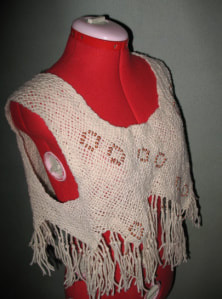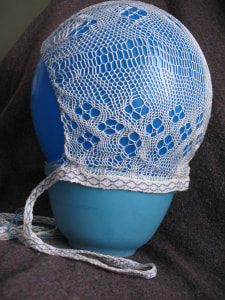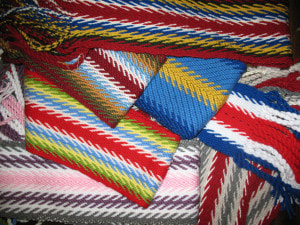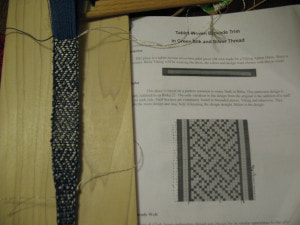|
I’ve been wanting to try something more than straight long pieces with this fingerweaving. To this end, I borrowed my daughter’s dressform, measured out lengths of wool, laid them over the shoulders and started weaving. Voilà the end result! A seamless garment! No shoulder seams, no sideseams. Next time, I’ll start with longer lengths so it will extend beyond my middrift. Nevertheless, I declare this attempt a success!
In other news, at the invitation of the Social Studies Teachers Association, I attended a teacher inservice day. I was invited to teach teachers to weave. What fun! I met a woman who had purchased my book last Summer, and was well into weaving her sash. So, you see, it is possible to learn using only the book Fingerweaving Untangled!
0 Comments
That bit of sprang that I started for the Viking Weekend in July 2008 has been sitting there, calling to me. So I finally finished it. Having learned from this experience, I’d do the next one a bit differently. The tablet woven band was wider where I left the weft for the sprang, and tightened up when I began weaving them separately for the ties. Next time I’d have two wefts going while I’m leaving off lengths for the sprang. I’d have one weft of a very fine thread (to hold the tablet weaving tight, and a second one to be shooting from one band to the other, making the warp for the sprang.
Joining the two tabletwoven bands at the back of the neck was another challenge. I am thinking that that fine weft would also help me to make this join. Trying to demonstrate the variety possible in this arrow sash genre, I began playing with acrylic yarn, and created several short pieces. Calling them neckscarfs, I’ve been selling them locally, encouraging folks to ‘design your own sash’. I was invited to the Canada Revenue Tax Center yesterday for their Aboriginal Awareness Day. I put up my display of sashweaving, and sold several books. Nice to know that the folks who collect your taxes have a human side to them. I’d like to think they have hobbies, relax, and are sensitive to cultural awarness issues. A friend came over today and we spent the afternoon with her tablet weaving, troubleshooting her problem with a brocading technique. At long last success! Come to find out, the problem was the direction of the threading in the cards, not with the brocading picking at all. I got the pattern working, then we got to chatting, and my attention wandered, and the pattern got a bit muddled. I went from using the two upper threads, to a single upper thread, and back to the double threads in the brocading. Quite interesting, and a nice change from the fingerweaving and loom weaving.
The current ‘Beginning Fingerweaving Class’ is about to end. Students are keen to set up their own sashes and start weaving away. It looks like they’ll continue to meet at the Musée de St-Boniface, so I’m thinking this is a great opportunity to start up a Fingerweaving Club. Anyone out there in the Winnipeg area is welcome to bring your sash and join us on Sunday afternoons, 1:30 to 3:30 PM. I received word yesterday that my next Mega-Project has been approved for funding by the Manitoba Arts Council. I’ve been intrigued by sashes I’ve seen, 4 of them now, all indisputably dating to the 1800’s and very loosely woven. How would someone weave that loosely, was my question. I am now going to test out a theory. This is my ‘two in one’ project. I will set up an extra long warp and fingerweave a sash, never un-doing the false weave. I’ve got the perfect extra long studio, the atrium of the St Boniface Hospital. I’ll shove every row of false weave all the way to the far end, causing the build-up of a second sash at the far end. All this is scheduled for the New Year. I’ll keep you informed. This from the Handweavers Guild of America publication, Shuttle Spindle & Dyepot, Fall 2008, a review of my book:
Fingerweaving Untangled, by Carol James. Self-published, 140, 4u3 Notre Dame, Winnipeg, Manitoba, R2H 0C1, Canada. 2008. Soft cover. 64 pages. $19.95 Described as “an illustrated beginner’s guide including detailed patterns and common mistakes,” this book is the perfect introduction to the ancient art of fingerweaving. Also known as ceinture fléchée or free end braiding, fingerweving has been used by American Indians, First Nations Peoples, and French-Canadians to make sashes, straps and belts. In fingerweaving, the warp and weft are continuous: one becomes the other to produce a warp-faced fabric. This many-stranded braiding technique takes us beyond the summer camp lanyard experience. James guides the reader from a beginner’s friendship bracelet through more complex patterns, and finally to the traditional designs of diamond, flame, arrowhead, Acadian, and Assomption. The book includes clear drawings with numbered step-by-step instructions. James includes a line drawing of her plan for a comfortable fingerweaving set-up, and she explains issues to help the weaver produce an evenly tensioned band. Just-in-time terminology accompanies clear photographs of the process and the product. Hints for troubleshooting and solutions to potential problems prevent the weaver from going astray, and finishing instructions are included. A collection of patterns includes step-by-step instruction and photographs, along with pattern descriptions, rules to follow, and pitfalls to avoid. The book ends with a selection of pattern graphs and a glossary. This book will appeal to anyone interested in historical textiles and braiding, along with fiber enthusiasts interested in simple, meditative techniques. Weavers interested in “back to basics” will find this book delightful. Reviewed by Elaine Bradley Atlanta Georgia Shuttle Spondle & Dyepot: Fall 2008 |
Categories
All
Archives
May 2023
Categories
All
|





 RSS Feed
RSS Feed